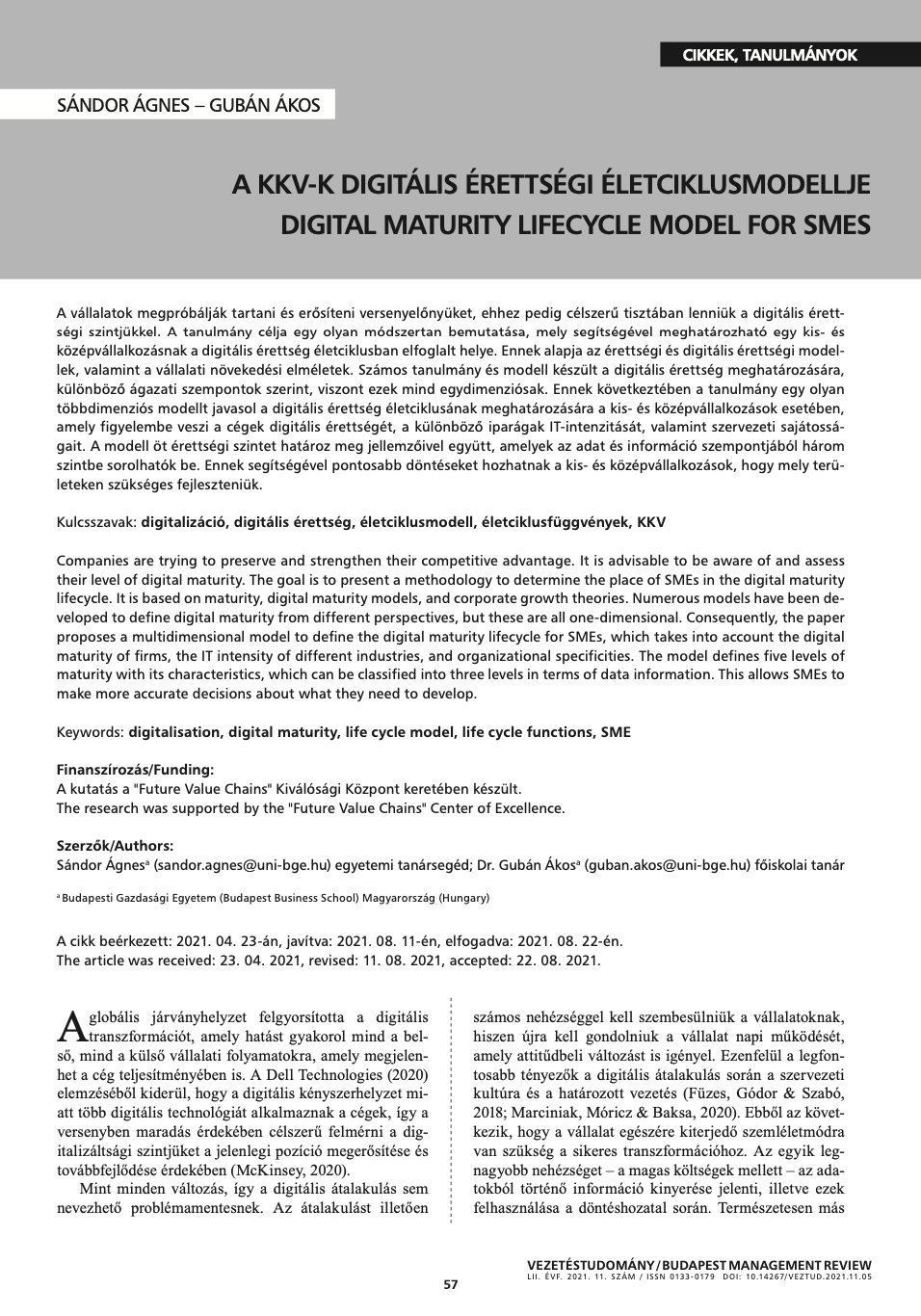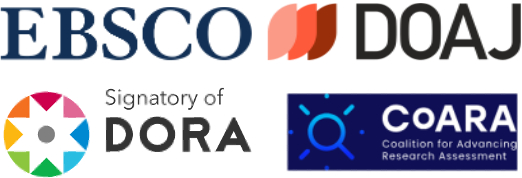A KKV-k digitális érettségi életciklusmodellje
DOI:
https://doi.org/10.14267/VEZTUD.2021.11.05Kulcsszavak:
digitalizáció, digitális érettség, életciklusmodell, életciklus-függvények, KKVAbsztrakt
A vállalatok megpróbálják tartani és erősíteni versenyelőnyüket, ehhez pedig célszerű tisztában lenniük a digitális érettségi szintjükkel. A tanulmány célja egy olyan módszertan bemutatása, mely segítségével meghatározható egy kis- és középvállalkozásnak a digitális érettség életciklusban elfoglalt helye. Ennek alapja az érettségi és digitális érettségi modellek, valamint a vállalati növekedési elméletek. Számos tanulmány és modell készült a digitális érettség meghatározására, különböző ágazati szempontok szerint, viszont ezek mind egydimenziósak. Ennek következtében a tanulmány egy olyan többdimenziós modellt javasol a digitális érettség életciklusának meghatározására a kis- és középvállalkozások esetében, amely figyelembe veszi a cégek digitális érettségét, a különböző iparágak IT-intenzitását, valamint szervezeti sajátosságait. A modell öt érettségi szintet határoz meg jellemzőivel együtt, amelyek az adat és információ szempontjából három szintbe sorolhatók be. Ennek segítségével pontosabb döntéseket hozhatnak a kis- és középvállalkozások, hogy mely területeken szükséges fejleszteniük.
Letöltések
Hivatkozások
Albukhitan, S. (2020). Developing Digital Transformation Strategy for Manufacturing. Procedia Computer Science, 170, 664–671. https://doi.org/10.1016/j.procs.2020.03.173
Berghaus, S., & Back, A. (2016). Stages in Digital Business Transformation: Results of an Empirical Maturity Study. MCIS 2016 Proceedings, 22. https://aisel.aisnet.org/mcis2016/22
Bititci, U. S., Garengo, P., Ates, A., & Nudurupati, S. S. (2015). Value of maturity models in performance measurement. International Journal of Production Research, 53(10), 3062-3085. https://doi.org/10.1080/00207543.2014.970709
Bogáth, Á. (2015). Kis- és középvállalatok méretbéli növekedésének hatása a szervezeti struktúrára. In Vállalkozásfejlesztés a XXI. században V. tanulmánykötet (pp. 145-159.). Budapest: Óbudai Egyetem. http://kgk.uni-obuda.hu/sites/default/files/10_BogathAgnes.pdf
Calvino, F., Criscuolo, C., Marcolin, L. & Squicciarini, M. (2018). A taxonomy of digital intensive sectors. OECD Science, Technology and Industry Working Papers, 18(4). Paris: OECD Publishing. https://doi.org/10.1787/f404736a-en
Caralli, R., Knight, M., & Montgomery, A. (2012). Maturity models 101: a primer for applying maturity models to smart grid security, resilience, and interoperability. Pittsburgh, PA: Carnegie Mellon University. https://doi.org/10.1111/j.1744-7429.2009.00516.x
Colli, M., Madsen, O., Berger, U., Møller, C., Wæhrens, B. V. & Bockholt, M. (2018). Contextualizing the outcome of a maturity assessment for Industry 4.0. IFAC-PapersOnLine, 51(11), 1347–1352. https://doi.org/10.1016/j.ifacol.2018.08.343
De Carolis, A., Macchi, M., Negri, E., & Terzi, S. (2017). A Maturity Model for Assessing the Digital Readiness of Manufacturing Companies. In Lödding H., Riedel R., Thoben KD., von Cieminski G., & Kiritsis D. (Eds.), Advances in Production Management Systems. The Path to Intelligent, Collaborative and Sustainable Manufacturing. APMS 2017. IFIP Advances in Information and Communication Technology, vol 513. (pp. 13-20). Cham: Springer. https://doi.org/10.1007/978-3-319-66923-6_2
Decker, A. & Jørsfeldt, L. M. (2017). Digitally Enabled Platforms: Generating Innovation and Entrepreneurial Opportunities for SMEs. In G. Tesar, & Z. Vincze (Eds.), Motivating SMEs to Cooperate and Internationalize: A Dynamic Perspective (pp. 111-130). London: Routldge. https://doi.org/10.4324/9781315412610
Dell Technologies (2020). Digital Transformation Index 2020. https://www.delltechnologies.com/en-us/perspectives/digital-transformation-index.htm#pdf
Deloitte (2018). Digital Maturity Model – Achieving digital maturity to drive growth. https://s16705.pcdn.co/wp-content/uploads/2018/08/Deloitte-DMM.pdf
Deloitte (2020). Uncovering the connection between digital maturity and financial performance. https://www2.deloitte.com/us/en/insights/topics/digital-transformation/digital-transformation-survey.html
Füzes, P., Gódor, Z., & Szabó, Z. R. (2018). Szabadulás a kiaknázási csapdából a digitális jövő alakításával. Hogyan irányítható az iparági változás egy felhőalapú szolgáltatásra épülő kiaknázási és felderítési tevékenységgel? Vezetéstudomány, 49(1), 54–64. https://doi.org/10.14267/veztud.2018.01.06
Gaál, Z., Szabó, L. & Obermayer-Kovács, N. (2009). „Tudásmenedzsment-profil” érettségi modell. Vezetéstudomány, 40(6), 2-15. https://doi.org/10.14267/VEZTUD.2009.06.01
Ganzarain, J. & Errasti, N. (2016). Three stage maturity model in SME’s toward industry 4.0, Journal of Industrial Engineering and Management, 9(5), 1119-1128. http://dx.doi.org/10.3926/jiem.2073
Garzoni, A., De Turi, I., Secundo, G., & Del Vecchio, P. (2020). Fostering digital transformation of SMEs: a four levels approach. Management Decision, 58(8), 1543–1562. https://doi.org/10.1108/MD-07-2019-0939
Gill, M. & VanBoskirk, S. (2016). The Digital Maturity Model 4.0. https://forrester.nitro-digital.com/pdf/Forrester-s%20Digital%20Maturity%20Model%204.0.pdf
Greiner, L. E. (1998). Evolution and revolution as organizations grow. Harvard Business Review, 76(3), 1-12. https://doi.org/10.1111/j.1741-6248.1997.00397.x
Gubán, Á. & Sándor, Á. (2021). A KKV-k digitálisérettség-mérésének lehetőségei. Vezetéstudomány, 52(3), 13–28. https://doi.org/10.14267/VEZTUD.2021.03.02
Issa, A., Hatiboglu, B., Bildstein, A. & Bauernhansl, T. (2018). Industrie 4.0 roadmap: Framework for digital transformation based on the concepts of capability maturity and alignment. Procedia CIRP, 72, 973–978. https://doi.org/10.1016/j.procir.2018.03.151
Kane, G. C., Palmer, D., Phillips, N. A., Kiron, D. & Buckley, N. (2017). Achieving Digital Maturity. MIT Sloan Management Review. https://sloanreview.mit.edu/projects/achieving-digital-maturity/
Kane, G. C., Phillips, N. A., Copulsky, J. R. & Andrus, G. R. (2019). The Technology Fallacy: How People Are the Real Key to Digital Transformation. Cambridge, MASS: MIT Press.
Klötzer, C., & Pflaum, A. (2017). Toward the Development of a Maturity Model for Digitalization within the Manufacturing Industry’s Supply Chain. In Proceedings of the 50th Hawaii International Conference on System Sciences (2017) (pp. 4210–4219). Hilton Waikoloa Village, HI, USA. https://doi.org/10.24251/hicss.2017.509
KSH (2008). Gazdasági tevékenységek egységes ágazati osztályozási rendszere. https://www.ksh.hu/docs/osztalyozasok/teaor/teaor_rovid_leiras.pdf
Kuusisto, O., Kääriäinen, J., Hänninen, K., & Saarela, M. (2020). Towards a Micro-Enterprise–Focused Digital Maturity Framework. International Journal of Innovation in the Digital Economy, 12(1), 72–85. https://doi.org/10.4018/ijide.2021010105
Levie, J., & Lichtenstein, B. B. (2010). A terminal assessment of stages theory: Introducing a dynamic states approach to entrepreneurship. Entrepreneurship: Theory and Practice, 34(2), 317-350. https://doi.org/10.1111/j.1540-6520.2010.00377.x
Linstedt, D. & Olschimke, M. (2016). The Data Vault 2.0 Methodology. Data Vault 2.0, 33–88. https://doi.org/10.1016/b978-0-12-802510-9.00003-9
Lloyds Bank (2017). UK Business Digital Index 2017 https://resources.lloydsbank.com/businessdigitalindex/
Marciniak, R., Móricz, P., Baksa, M. (2020). Lépések a kognitív automatizáció felé: Digitális átalakulás egy magyarországi üzleti szolgáltatóközpontban. Vezetéstudomány, 51(6), 42-55. https://doi.org/10.14267/VEZTUD.2020.06.05
McKinsey (2020). How COVID-19 has pushed companies over the technology tipping point—and transformed business forever. https://www.mckinsey.com/business-functions/strategy-and-corporate-finance/our-insights/how-covid-19-has-pushed-companies-over-the-technology-tipping-point-and-transformed-business-forever
Mittal, S., Romero, D. & Wuest, T. (2018). Towards a smart manufacturing toolkit for SMEs. IFIP Advances in Information and Communication Technology, 540(August), 476–487. https://doi.org/10.1007/978-3-030-01614-2_44
Mullaly, M. (2014). If maturity is the answer, then exactly what was the question? International Journal of Managing Projects in Business, 7(2), 169–185. https://doi.org/10.1108/IJMPB-09-2013-0047
Nagy J. (2017). Az ipar 4.0 fogalma, összetevői és hatása az értékláncra (167. sz. Műhelytanulmány). Budapest: Budapesti Corvinus Egyetem. http://unipub.lib.uni-corvinus.hu/3115/1/Nagy_167.pdf
North, K., Aramburu, N., & Lorenzo, O. J. (2019). Promoting digitally enabled growth in SMEs: a framework proposal. Journal of Enterprise Information Management, 33(1), 238–262.0 https://doi.org/10.1108/JEIM-04-2019-0103
PWC (2015). Industry 4.0: Building the digital enterprise. https://www.pwc.com/gx/en/industries/industries-4.0/landing-page/industry-4.0-building-your-digital-enterprise-april-2016.pdf
Rafael, L. D., Jaione, G. E., Cristina, L. & Ibon, S. L. (2020). An Industry 4.0 maturity model for machine tool companies. Technological Forecasting and Social Change, 159(July), 120203. https://doi.org/10.1016/j.techfore.2020.120203
Salamonné Huszty, A. (2006). Magyarországi kis- és középvállalkozások életútjának modellezése. Competitio, 5(1), 51–68. https://doi.org/10.21845/comp/2006/1/3
SAP (2017). Maturity Model and Best Practice: Skill Development for Digital Transformation. Munich: SAP affiliate Technical University of Munich.
Schumacher, A., Nemeth, T. & Sihn, W. (2019). Roadmapping towards industrial digitalization based on an Industry 4.0 maturity model for manufacturing enterprises. Procedia CIRP, 79, 409–414. https://doi.org/10.1016/j.procir.2019.02.110
Simon, P. (2013). Differenciálegyenletek és dinamikai rendszerek (Digitális Tankönyvtár). Budapest: ELTE.
Sukova, L. (2020). Greiner’s Model and Its Application in Automotive Companies in the Czech Republic. Acta Informatica Pragensia, 9(1), 18–29. https://doi.org/10.18267/j.aip.129
Szabó, Zs. R. (2012). Innováció vezetői szemmel. Egy könyv azoknak a vezetőknek, akik a jövőt formálják. Budapest: Aula.
Szalavetz, A. & Somosi, S. (2019). Ipar 4.0-technológiák és a magyarországi fejlődés-felzárkózás hajtóerőinek megváltozása – gazdaságpolitikai tanulságok. Külgazdaság, 63(3-4. sz.), 66 –93. http://real.mtak.hu/102426/1/Szalavetz-Somosijav1korrekturanelkul2.pdf
Thordsen, T., Murawski, M., & Bick, M. (2020). How to Measure Digitalization? A Critical Evaluation of Digital Maturity Models. In Hattingh M., Matthee M., Smuts H., Pappas I., Dwivedi Y., & Mäntymäki M. (Eds.), Responsible Design, Implementation and Use of Information and Communication Technology. I3E 2020. Lecture Notes in Computer Science, vol 12066. Cham: Springer International Publishing. https://doi.org/10.1007/978-3-030-44999-5_30
Valdez-de-Leon, O. (2016). A Digital Maturity Model for Telecommunications Service Providers. Technology Innovation Management Review, 6(8), 19–32. https://doi.org/10.22215/timreview1008
Zsupanekné Palányi, I. (2007). A vállalati növekedés a vállalati életciklus-modellek tükrében. In Tudományos évkönyv 2007: reformok útján (pp. 45-56). Budapest: Budapesti Gazdasági Főiskola.

Downloads
Megjelent
Hogyan kell idézni
Folyóirat szám
Rovat
License
Copyright (c) 2021 Vezetéstudomány / Budapest Management Review

This work is licensed under a Creative Commons Attribution 4.0 International License.
Authors assign copyright to Vezetéstudomány / Budapest Management Review. Authors are responsible for permission to reproduce copyright material from other sources.

